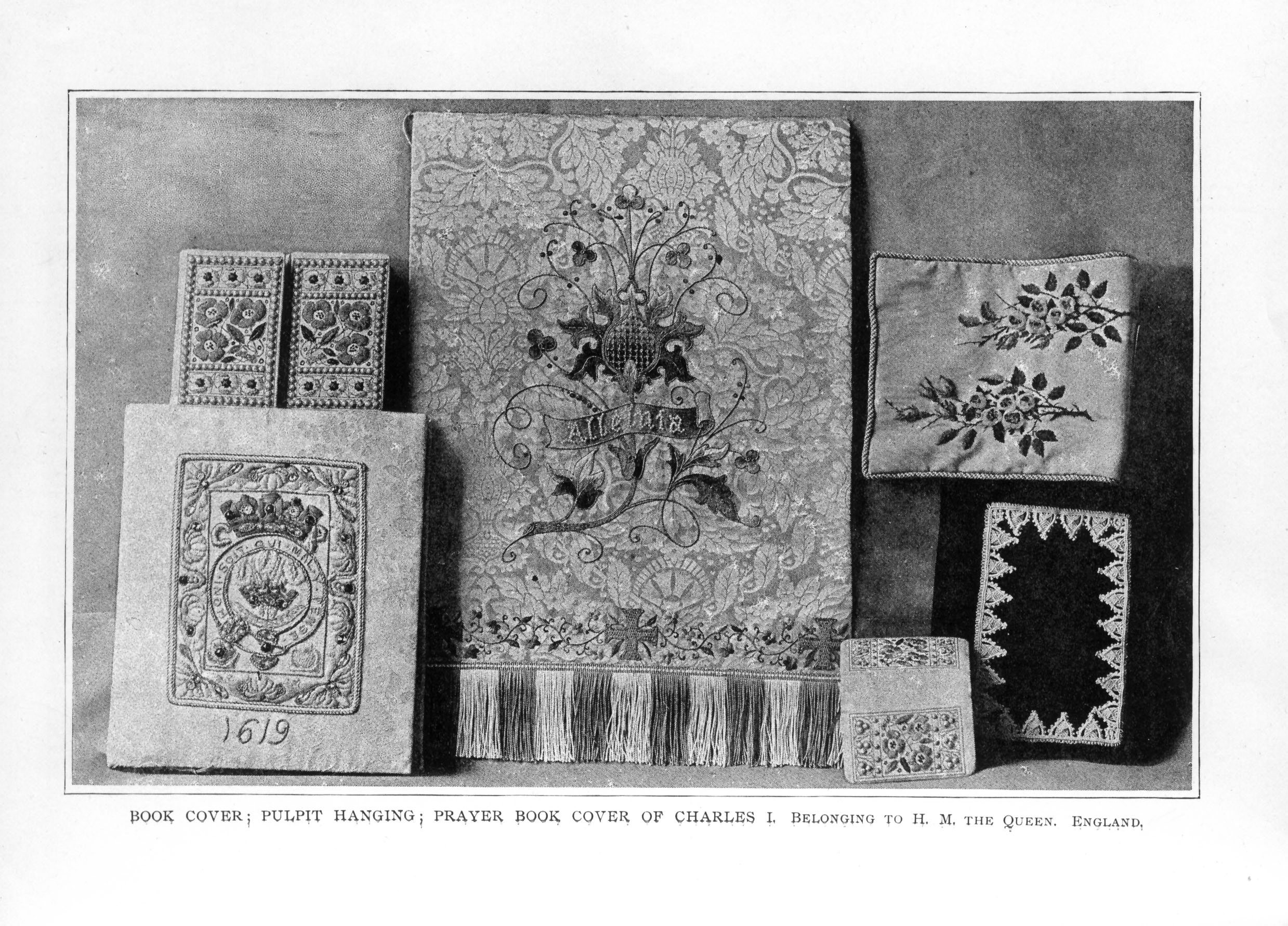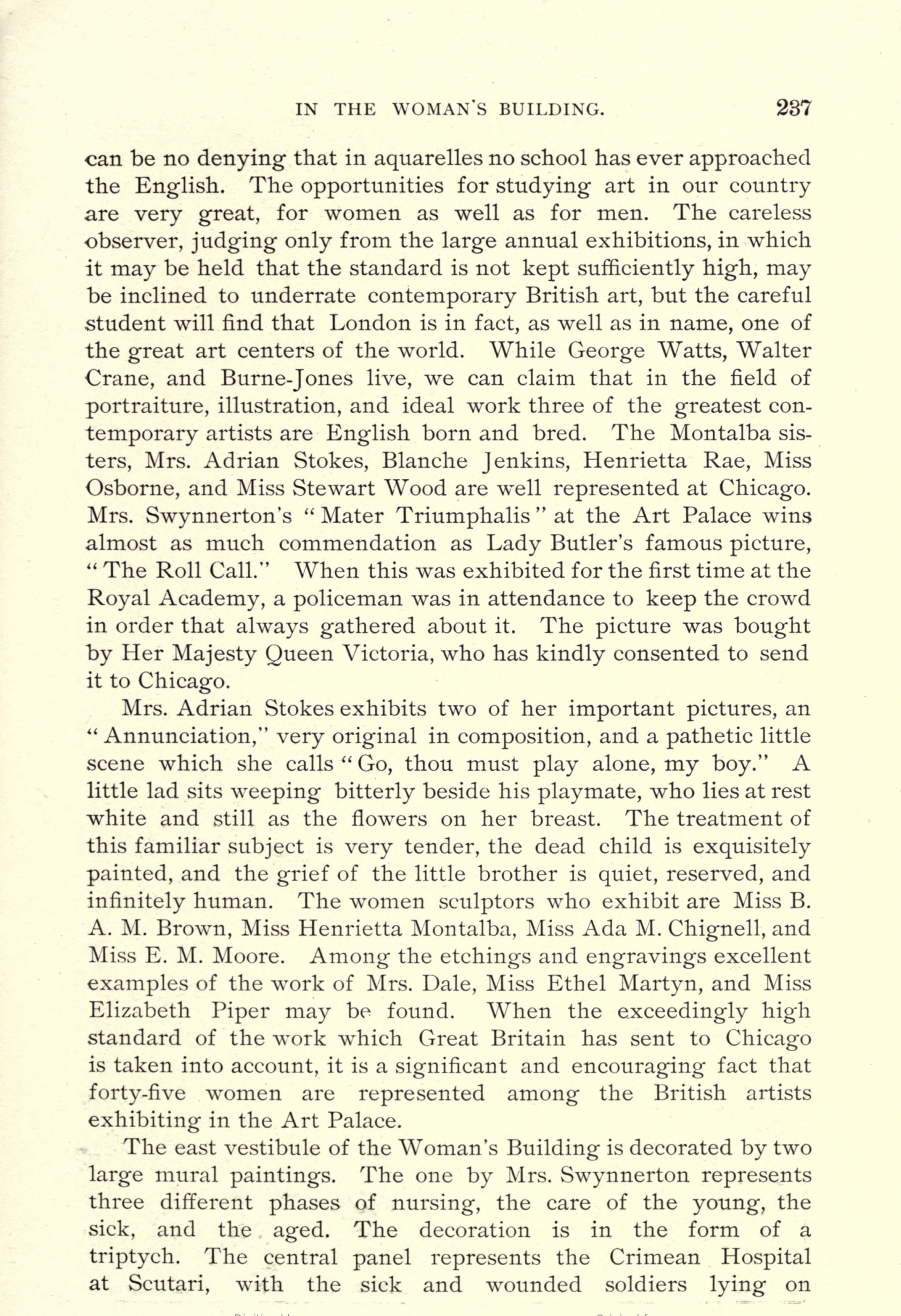
GREAT BRITAIN—ART.
GREAT Britain is justly proud of her women artists, some of whom are represented in the Woman's Building, but to judge of all that they are exhibiting at Chicago, the visitor must look in at the Art Palace and see some of the strong pictures exhibited there. It is nothing new to find English women in the front ranks of British art. They have always held a distinguished position, and in any book which pretends to give the history of women's achievements in art a very large proportion of the painters will be found to have been English, either by birth or by adoption. It is interesting to remember that a woman painter was one of the original members of the Royal Academy, whose charter was signed by King George III., at the instance of the American painter Benjamin West, who, after the death of Sir Joshua (first president of the Academy), held the position of president during the remainder of his life. In the art exhibitions of London, women to-day hold a prominent position. Mrs. Alma Tadema is a painter with a great deal of originality and of power. Her husband has been heard to say that his highest ambition is to have it written on his tombstone, "Here lies the husband of Mrs. Alma Tadema." Mrs. Stillman is one of our popular painters. Her pictures possess a certain ideal quality which is not always to be found combined with the admirable technique which we find in her work. Miss Lena Stillman, one of our younger artists, is full of promise. There is a certain gravity and dignity about her compositions which win for them immediate recognition. Kate Greenaway's name is a household word. Her delightful illustrations are known in every home where children and good taste are to be found. She has done more, perhaps, to bring about an improvement in the dress of our little men and little maids than any other individual. One meets whole groups of Kate Greenaway children in Hyde Park on a Sunday morning. Mrs. George Watts has achieved a reputation by her admirable portraits.
In the use of water-colors, women share the high position that our English artists hold in that exquisite branch of art, for there

BOOK COVER; PULPIT HANGING; PRAYER BOOK COVER OF CHARLES I. BELONGING TO H. M. THE QUEEN. ENGLAND

can be no denying that in aquarelles no school has ever approached the English. The opportunities for studying art in our country are very great, for women as well as for men. The careless observer, judging only from the large annual exhibitions, in which it may be held that the standard is not kept sufficiently high, may be inclined to underrate contemporary British art, but the careful student will find that London is in fact, as well as in name, one of the great art centers of the world. While George Watts, Walter Crane, and Burne-Jones live, we can claim that in the field of portraiture, illustration, and ideal work three of the greatest contemporary artists are English born and bred. The Montalba sisters, Mrs. Adrian Stokes, Blanche Jenkins, Henrietta Rae, Miss Osborne, and Miss Stewart Wood are well represented at Chicago. Mrs. Swynnerton's "Mater Triumphalis" at the Art Palace wins almost as much commendation as Lady Butler's famous picture, "The Roll Call." When this was exhibited for the first time at the Royal Academy, a policeman was in attendance to keep the crowd in order that always gathered about it. The picture was bought by Her Majesty Queen Victoria, who has kindly consented to send it to Chicago.
Mrs. Adrian Stokes exhibits two of her important pictures, an "Annunciation," very original in composition, and a pathetic little scene which she calls "Go, thou must play alone, my boy." A little lad sits weeping bitterly beside his playmate, who lies at rest white and still as the flowers on her breast. The treatment of this familiar subject is very tender, the dead child is exquisitely painted, and the grief of the little brother is quiet, reserved, and infinitely human. The women sculptors who exhibit are Miss B. A. M. Brown, Miss Henrietta Montalba, Miss Ada M. Chignell, and Miss E. M. Moore. Among the etchings and engravings excellent examples of the work of Mrs. Dale, Miss Ethel Martyn, and Miss Elizabeth Piper may be found. When the exceedingly high standard of the work which Great Britain has sent to Chicago is taken into account, it is a significant and encouraging fact that forty-five women are represented among the British artists exhibiting in the Art Palace.
The east vestibule of the Woman's Building is decorated by two large mural paintings. The one by Mrs. Swynnerton represents three different phases of nursing, the care of the young, the sick, and the aged. The decoration is in the form of a triptych. The central panel represents the Crimean Hospital at Scutari, with the sick and wounded soldiers lying on

MARQUETRY SCREEN.
LENT BY THE WORKING LADIES' GUILD.
ENGLAND.

their pallet beds, their faces turned toward the single gracious figure of Florence Nightingale standing in their midst, a figure full of dignity and of pathos. It was in this hospital that the dying boy kissed the shadow of Florence Nightingale as it fell upon the wall by his bed. In one of the smaller panels we have a handsome, robust young mother with a lusty child upon her knee, while the remaining one shows us the figure of an aged woman; beside her sits her young granddaughter. One feels here that the situation is reversed; the young girl is repaying something of the care and love which in her infancy were lavished upon her. There is a wealth of sentiment and tenderness in this three-fold presentation of woman's great duty and prerogative, the care of the weak and helpless. Facing Mrs. Swynnerton's decoration are three corresponding panels by Mrs. Anna Lee Merritt, who, though by birth an American, has for so long lived and worked in England that we may fairly claim her for one of our painters. The central panel is a spirited scene, representing woman the mistress of the needle. A group of seated figures about an embroidery frame is particularly worthy of notice. In the right-hand panel a group of fair girl graduates receive their diplomas from the hand of a college dignitary. It is interesting to learn that the process used by Mrs. Merritt in this decoration is a novel one which has only lately been known in England. The whole work was executed between the 1st of February and the 8th of April, which gives us an idea of the artist's industry. In justice to Mrs. Swynnerton and Mrs. Merritt, it should be said that their work is seen at something of a disadvantage owing to the narrowness of the vestibule in which it is placed. It would be seen at a much better advantage at a far greater distance than is here possible. Miss Clara Montalba exhibits a charming little picture of the palace in Venice where Robert Browning lived, and from whence his body was carried in that wonderful funeral pageant when the English poet, lying in his flower-crowned barge, was carried down the Lido, followed by all the dignitaries and notables of Venice. Hilda Montalba's "Market Woman of Dordrecht" is clever and well drawn, and deserves the commendation which it received when it was exhibited last year in the Royal Academy. Miss Alice Grant's "Portrait of a Baby" shows us a jolly little wight, full of fun and good humor. Mrs. Perugini's "Portrait of a Child" is a characteristic piece of work. The "Sussex Cottage" by Mrs. Allingham and the charming landscape by Miss Stewart Wood have been widely admired. Henrietta Rae's large picture of "Eurydice Sinking

CUSHION.
DESIGNED BY H. R. H. THE PRINCESS LOUISE.
ENGLAND.
Back into Hades" is a very powerful composition. The artist has chosen the moment when the beloved shade vanishes from the eyes of the agonized Orpheus and sinks sadly and mutely back to the nether world from which his insistent adjurations have summoned her.
In sculpture women are achieving as great a success in England as they are in France and in the United States. One of the most beautiful pieces of sculpture exhibited last year in London was the bas-relief of "Silene," shown at the Royal Academy by one of our leading women sculptors. Her Royal Highness the Princess Louise has won distinction both in painting and in sculpture. Her portrait of Paderewski and the bust of her royal mother, exhibited last year, merited the high praise they received.
In needlework and embroidery our women have never been surpassed, and it is a cause of great satisfaction to us to learn that the Kensington school, which has done so much to improve the art

of the needle in Great Britain, has extended its potent influence throughout the United States, and that the leading schools of needlework in this country acknowledge that they owe their very existence to the Kensington school.
In music we are not behind. Virginia Gabriel's songs have had a wide and well-deserved popularity, shared by the compositions of Elizabeth Philp. Among our younger composers, two of the most eminent, Rosalind Ellicott and Ethel Smythe, have contributed manuscript copies of some of their best-known works.
In commerce woman is taking every day a more prominent place. In the old days, the only refuge for a reduced gentlewoman was the profession of a governess or companion, but to-day we find many women of good family who find in trade an excellent and dignified means of self-support. Several ladies of rank, as is very well known, have opened millinery and dressmaking establishments.
In philanthropic work Englishwomen have long been prominent, while in literature they have maintained the high position won for them by Maria Edgeworth, George Eliot, Elizabeth Barrett Browning, and the Brönte sisters. Among our most popular novelists today are Miss Braddon, Ouida, Rhoda Broughton, Mrs. Lynn Linton, Mrs. Alexander, Mrs. Humphrey Ward, and the late Miss Edwards, whose fame as an archaeologist has almost eclipsed her work in literature. Frances Power Cobb is a name worthy to close this very imperfect survey of the women who to-day are among the leading spirits in the fields of intellectual labor. The work of women may be likened to the labor of the coral insects who for centuries toil unseen and unnoticed beneath the ocean of oblivion. At last a day comes when the winds and the waves bring their tribute of soil, the passing birds drop the seeds of tree and flower, and of a sudden a fair island rises from the sea, with fruit and foliage and pleasant streams. The navigator discovers the new land and writes it down on his chart, and the patient toil of the untold myriads of insects is at last rewarded.
E. CRAWFORD.
Mrs. Crawford, the writer of this paper, exhibits one of the most striking pictures in the Hall of Honor, a large water-color painting of a Roman scene; a nun passing up a marble stairway, and looking back at a cheerful young peasant woman leading a rosy child and carrying a funeral wreath. The colors used in this work are of a new manufacture, and attention is called to the reds, which have proved very satisfactory.—ED.

"THE END OF THE HOP HARVEST."
MISS STUART WOOD.
ENGLAND.